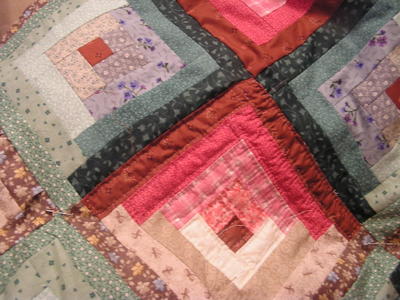And sewing has also been one of my biggest challenges in the traditional "womanly" arts. I just haven't the patience for it. It is an incredibly exact science that cannot be rushed -- for often a rush job cannot be fixed.
Sewing my own clothing is something I've tried and not enjoyed. But during the term I took off from school, I decided to try my hand at quilting. I made one quilt that time, and it is definitely of a beginner's skill. For Meg's wedding, I'd promised her a quilt. She picked out the style and the colors and I started cutting last summer, but it was just this very weekend that all of the pieces were finally assembled.

It really looks nice from a distance, but if you get close to it you can see how blocks do not line up, and all the gathers and gaps and irregularly shaped pieces. When it's finished, it will look great again. But that' s a long time away!
The whole process, which I love and hate, is so detailed.
1. Pick out your pattern. Pick out your color scheme. Figure out how much fabric you need for all NINE colors. Then go back and get more when you figured wrong.
2. Cut. And cut. And cut some more. (Although with this "Log Cabin" design, a new method incorporates ripping strips of fabring along the grain -- but it seems less exact to me.) Oh, and by cutting, I don't mean just get out the Fiskars. Quilts are cut out with rolling razorblades, using a clear plastic guide to get to the very hair-fraction of perfect rectangles.
3. Sew -- starting with the tiniest pieces, joining first the individual squares. Then join two squares. Then join two squares with two squares...until the whole blasted thing is one. Then add borders. But, any time two pieces are not joined exactly on dead-straight edges, the entire quilt will be a little "off" in its lines. Or if there are a lot of mistakes, it could be "a whole lot" off, as it was for me.
3. Just as half of journalism is waiting for people to return your calls, half of quilting is not sewing but ironing. And my mother can tell you how I feel about ironing. After EVERY seam made in the entire quilt, the seam must be pressed. Must. Believe me, if I could get away without doing it, I would. So, see every piece in the quilt? Multiply that number by about three, and that's at least how many times I ironed. And this is just a twin-size!
4. After the entire top is prepared, you ignore it. The bottom must be prepared. Depending on size, special quilter's muslin is available that is extra-extra wide and no sewing (just more ironing) may be required. The bottom is laid out on the ground, and a cotton batting is rolled out on top of it. The top goes (obviously) ontop of that, making a batting sandwich. Then it must all be smoothed out and lined up just so.

5. Next, pinning. Go to the center of the quilt and safety pin through all three layers (and NOT the carpeting). Then go out a short bit and pin again, until the whole quilt is pinned at regular small intervals. You might be able to see a few pins above. Special curved safety pins are available so that you don't have to pick the quilt up off the ground to get the pin in.
6. Finally, there is a choice. Some quilts you have may have yarn hanging from them. That's how that quilter chose to bind the blanket. To my knowledge, the more binding together of the layers, the more warm the blanket will be.
Real finesse in a quilt can be added through "quilting." Quilting is the simplest and only un-messy part of the whole process. It can also be the most time consuming, as it consists of taking a needle and thread and simple stitching inside the border of every single piece of the quilt (or you can make other patterns). Many professional quilters send their quilts out to quilt shops to be quilted, where it can be done on a machine. But I prefer the love and personalization that goes into doing it by hand. And you can quilt while you watch TV (though you can't actually watch the TV) or while you watch a movie or listen to music or have a conversation.
I started quilting Meg's quilt yesterday. I am hoping to be done by Christmas, and that should be quite possible. It would be even nicer to have it done for her birthday in a month, but that seems like a major stretch. Below, you can notice the lowest square has been partially quilted. This quilt is really benefitting from the quilting -- I think it gives it real personality and age.

7. Finishing the edges. I don't even remember how I did it last time, but I remember hating it. There is supposedly another way that looks nicer and involves bias tape, and I am hoping to learn it soon!
That's all from here. Hope this helps you appreciate your blankets a little more!
No comments:
Post a Comment